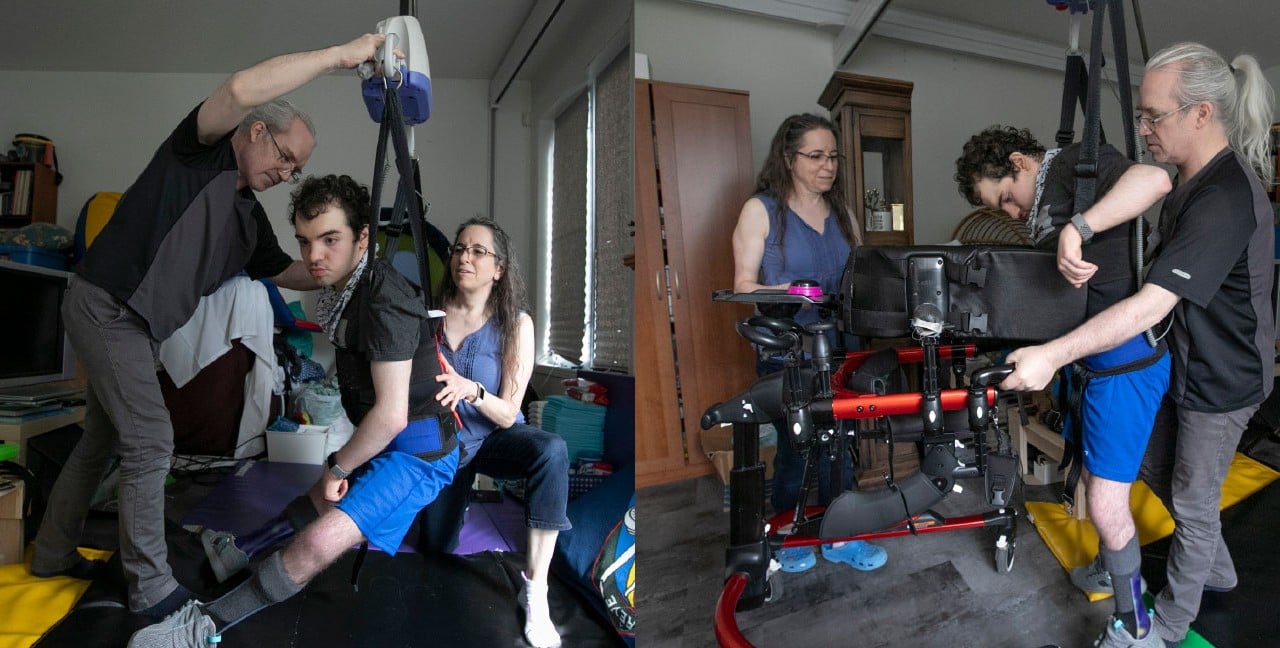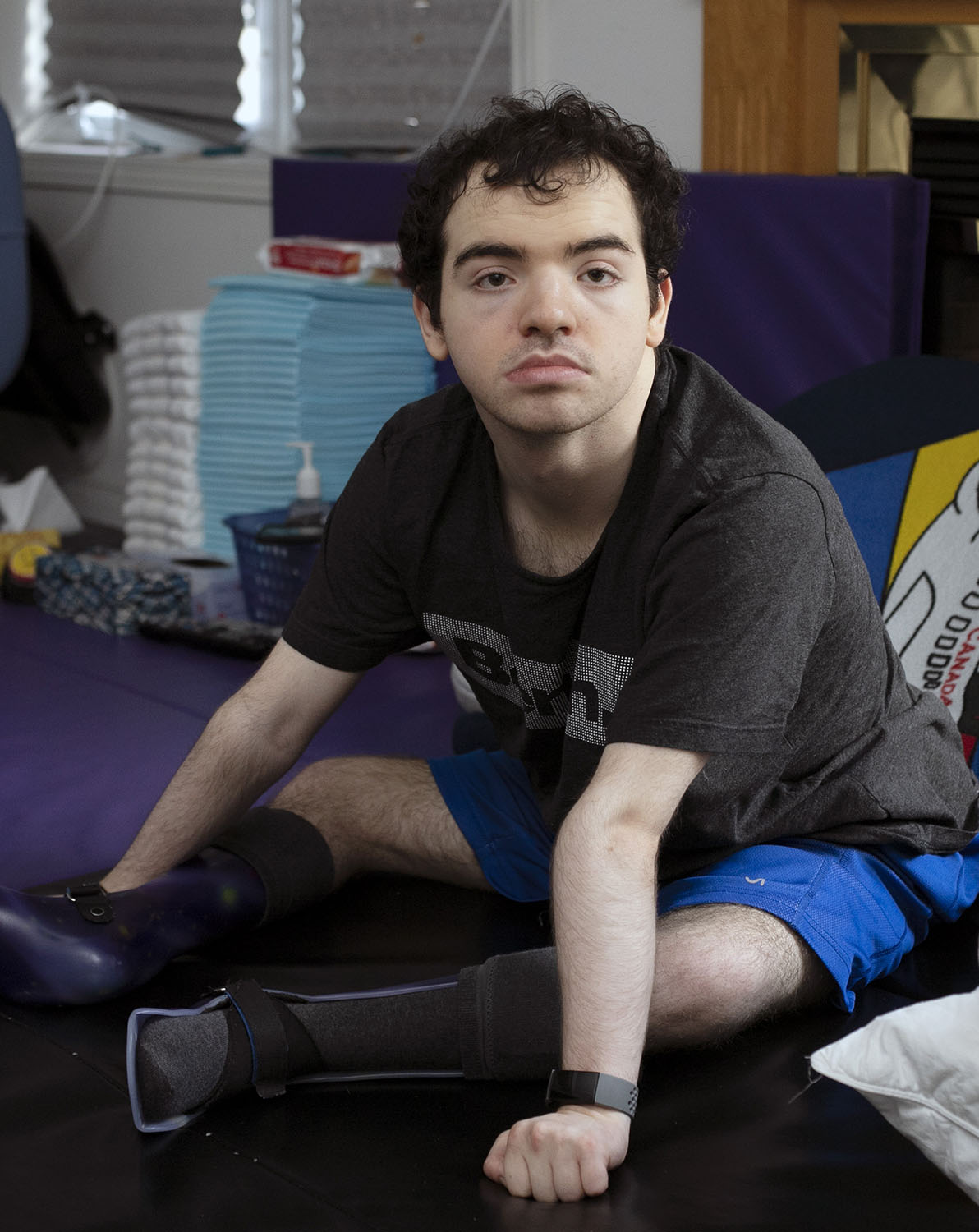This article originally appeared in the Fall 2021 issue of the Ontario Medical Review magazine.
One family’s story illustrates why the entire system urgently needs increased funding.
Sharon Liff has been an electrical engineer, pianist, aerobics instructor, choral singer, personal trainer, bus driver and ham radio operator. She’s used to having a lot on the go.
“I’ve always liked to reach,” the Ottawa mother said. “That’s just my personality.”
In the past several years, though, she has had to let go of almost all these pursuits to make room for one thing: caring for her 19-year-old son Adam Liff-Neilson.
Adam has a rare genetic condition called Pelizaeus-Merzbacher Disease. It affects his brain and spinal cord, inhibiting his co-ordination, motor skills and learning abilities. He needs 24-hour caregiver assistance for everything from eating to toileting.
Before each feeding-tube meal, he needs his stomach “vented” to release the gases that would otherwise cause him pain and bloating. He’s fed by hand eight to 10 times per day, and requires a diaper change once or twice per night and up to nine more times during the day. He needs medicine each morning and throughout the day for seizure prevention, ulcer prevention, and other conditions.
“It was getting harder and harder to find qualified people. I used to hire support workers from camps Adam attended to work part-time for us. But they’re no longer available. It happened gradually. It actually took me a while to notice because I had so much to worry about.” –Sharon Liff
He gets around in a wheelchair or walker, and also uses a standing frame, all of which require lifting to get into and out of. Adam is non-verbal and requires daily assistance to exercise, learn and bathe. And he needs the company of other caring people for his emotional well-being.
While Sharon and her husband Rick Neilson are more than willing to make personal and professional sacrifices to ensure Adam has the care he needs, they can’t do it alone.
“Rick has given up his career for this. We’ve both given up a lot,” she said. “We love our son. He’s a great kid. But his care is so onerous.”
Stories of families like that of Adam and his parents were one of the driving forces behind the recommendations in Prescription for Ontario: Doctors’ 5-Point Plan for Better Health Care. The Ontario Medical Association is advocating for better home-care services both to improve public health, and the situation for people like Adam, Sharon and Rick.
Current gaps in home-care support not only affect the quality of life for family caregivers, but also the quality of care itself. Adam needs types of professional medical assistance that his parents never trained for, including the help of personal support workers (PSWs), developmental services workers (DSWs), and trained nurses.

Deficiencies with home care began well before COVID-19 but became more pronounced and severe because of the pandemic.
“It was getting harder and harder to find qualified people,” Sharon said. “I used to hire support workers from camps Adam attended to work part-time for us. But they’re no longer available. It happened gradually. It actually took me a while to notice because I had so much to worry about, but at some point, I just thought, ‘Wow, there’s really no one out there.’ It was getting bad before the pandemic started, and then the pandemic just killed it.”
She and Rick often go weeks without being able to find help during the day. She struggled even to find time to sit down and be interviewed for this story.
In addition to general shortages, PSWs and DSWs often choose to work in care facilities rather than private homes, which can offer regular hours, benefits and higher hourly rates. Even when Sharon and Rick receive government funding to pay for home-care assistance, they can’t compete with larger facilities.
“The entire health system is struggling to find enough qualified front-line staff,” said Shirlee Sharkey, president and CEO of SE Health, a not-for-profit provider of home-care services. “Hospitals, long-term care homes, public health units, community providers and individual families are often vying for the same talent. There’s a limited pool and it’s very competitive.”
 Organizations like SE Health have had to find ways to recruit and retain staff. Sharkey’s organization currently runs 24 free PSW training programs across the province. They hope to urgently certify 450 new PSWs to join their team.
Organizations like SE Health have had to find ways to recruit and retain staff. Sharkey’s organization currently runs 24 free PSW training programs across the province. They hope to urgently certify 450 new PSWs to join their team.
“Beyond increasing the overall supply of health providers, we also need to do a better job at keeping and engaging them,” she said. “We need new funding models and more balanced investment models to ensure fair compensation for a qualified workforce.”
Sharkey pointed out that a typical PSW working at a hospital earns nearly 20 per cent more than an equally qualified worker in the home-care sector. For a registered nurse the average hourly rate is $11 higher in hospitals. Addressing these inequities, as well as prioritizing better working conditions could go a long way toward alleviating the kinds of challenges Sharon and Rick face.
Even when they can find support workers, they often cancel at the last minute because they’ve been called in for an extra shift at their main job, or because they’re just burnt out. With no give in the system, Adam’s round-the-clock care falls to his parents. They work as a team, trading off duties and giving each other breaks as best they can, but the situation is unsustainable.
“It’s killing us,” said Sharon, though the rewards of having Adam in their lives make it all worthwhile. “Adam is a very happy guy. You can see how much he loves his father. They watch Seinfeld together during feeds. They are great buddies. And when I’m with him, I’m over-the-top silly because it makes him laugh.”
The challenges presented by Adam’s condition aren’t new to Sharon: she’s been dealing with them since he was a baby.
“Over the first three months, we realized he wasn’t hitting any milestones. We bought all the books. They told us what to expect at every moment, but I thought to myself, ‘My child might not be anything like this’,” she said. “I met up with other mothers. It was nice to get all the kids together, but I watched them all develop, while Adam was just lying there.”
When he was two years old, genetic testing led to a definitive diagnosis of Pelizaeus-Merzbacher Disease. He required surgery on his digestive system when he was three years old and had to begin using a feeding tube as he was unable to chew and swallow safely. The family faced many more medical interventions in the years that followed.
“The surgery took a lot out of us. It went on and on, and it was just stressful. I was begging and begging for help,” she said, remaining grateful to the nurses who were part of the family’s home-care routine in those early days. But Adam’s needs increased over the years, while staff and funding diminished.
“Home-care workers look after a million people in Ontario every year. That’s massive. More than 90 per cent of people want to live in their homes and receive care in their homes as they age. But there has been very little attention paid to the home-care system by successive governments.” –Sue VanderBent, Home Care Ontario
She would like to see the provincial government place greater emphasis on promoting programs to train DSWs. Such programs provide the exact kind of training she knows Adam needs in a home caregiver.
“They have the training to work with people in wheelchairs or who might be non-verbal. They have the knowledge to deal with developmental issues,” she said.
She knows first-hand that DSW work isn’t always easy, which is precisely why she believes it should be better promoted and appreciated.
“They’re the ones who are going to help. They’re in this field because they care.”
Sue VanderBent, CEO of Home Care Ontario, a member-based organization representing home-care service providers, agrees that increasing the number of DSWs is part of the solution, but much more is also needed to address needs across the province.
“This is a big systemic problem, and it’s not new,” VanderBent said.
In her career as a social worker, she witnessed first-hand how many parts of the health-care system, including acute and long-term care, community support, and mental health and addictions, increasingly suffered from a lack of resources. Home care, she said, is an important part of turning the whole system around into something that works better for Ontarians.
“Home-care workers look after a million people in Ontario every year. That’s massive,” she said. “More than 90 per cent of people want to live in their homes and receive care in their homes as they age. But there has been very little attention paid to the home-care system by successive governments.”
In addition to improving the lives of families like Adam’s, robust home care also protects the hospital system, reduces costly trips to the ER, and eases the burden on family doctors, VanderBent said.
“But it’s not until private troubles become public issues that they get the attention they deserve,” she said.
Which is what led Sharon to add one more activity to her already-packed life: advocacy, including helping to inform and support the OMA’s recommendations.
“I want to help as many people as I can by raising awareness,” she said. “I’m more connected because Adam is so profoundly disabled, and I want to do this because it’s important. If anything I say resonates, it’s because it’s the truth.”
Patchen Barss is a Toronto-based writer.